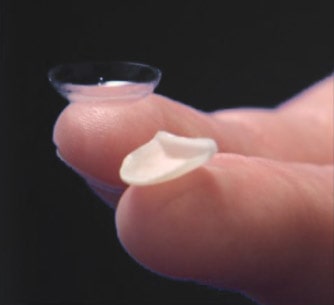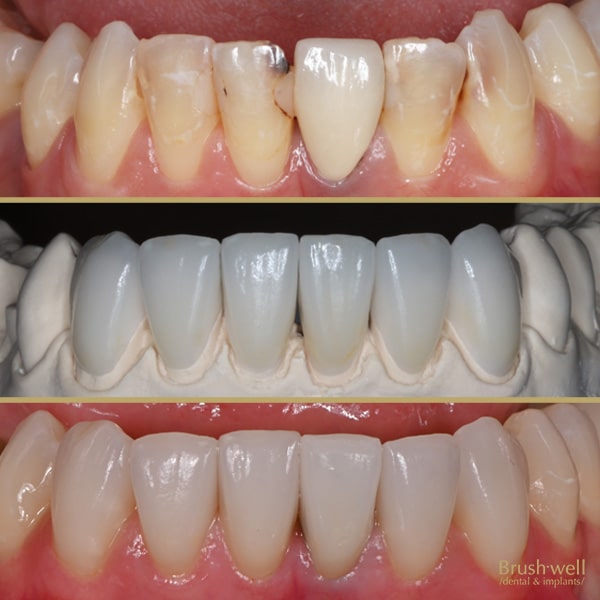Dental Veneers
We often hear patients say, “I want my smile back.” Unfortunately, many people lose their smile due to several reasons that could be fixed with dental veneers. Some of the contributing reasons are as follows: 1. worn-down teeth leads to a “collapse” of the lower third of a face, 2. lips fall over the teeth due to loss of facial volume, 3. filler may increase the skin’s weight, pushing it further below (over the teeth).
One of the aims of dental veneers may be to make your smile more visible, proportional to your face, and functionally intact. We may increase the vertical dimension of your teeth if necessary. And possibly design the upper teeth out to fruther support your natural lip position. These will help with the balance of your bite and protect against future wear.
What are dental veneers?
Dental veneers are ultra-thin, ceramic shells that look like teeth and bond to the front surface of teeth. They are a popular choice amongst patients who want to improve the aesthetics of their misshaped, worn, and/or gapped teeth.

Compare a dental veneer to a contact lens
What are dental veneers made of?
Our veneers are crafted from the highest quality porcelain, which offers the following benefits:
- They are robust and long-lasting.
- They give the resemblance of a natural-looking tooth surface.
- They require less enamel removal than crowns.
- They’re highly stain-resistant. Great for coffee and tea lovers!
Do porcelain veneers really look like natural teeth?
We’ve seen many poorly designed veneers with the wrong shape, size, and color gradient. However, at Brushwell Dental, we specialize in designing natural-looking veneers and implants. And to re-create hyperrealistic teeth that functions properly isn’t easy; it requires an obsessive attention to detail. And what drives our obsession is knowing that our patients won’t walk out of our office the same person. They leave transformed.

What’s involved?
- To prepare your teeth, if necessary, the dentist reduces a minimal outer layer of the front of your tooth. Minimal meaning ±0.5mm reduction. Sometimes no reduction is necessary. By doing so, the veneer has space to rest on that gives your teeth that natural look (without any awkward protrusions).
- The dentist makes a mold impression of the prepared teeth and collaborates with you on the veneer shade that will you the look you want. Some people want whiter teeth, others more natural-looking teeth.
- This mold impression helps our master ceramist custom craft with precision to fabricate life-life veneers. This may take several weeks. And in the meantime, you will be given beautiful temporary veneers to wear.
- Once the veneers are crafted and delivered, the dentist places them on your teeth while assessing the fit, shape, and contact. After careful adjustments are made, your teeth are cleaned for proper bonding surface. Then your veneers are placed and bonded.
- Further adjustments may be made at a future follow-up appointment if needed.
What to consider before getting veneers?
- Your teeth and gums must be be healthy in order to get veneers. Allow your dentist to treat any cavities or gum disease before having veneers placed.
- Veneers are not indicated for every person, that is why recommend meeting our doctors for a consultation.
- The process of removing your enamel for veneers is irreversible. Even though only a small amount of enamel is removed, it is permanent. Thus, we take the consultation and planning seriously.
- It is possible for veneers to loosen over time. If this occurs, a new replacement may be required.
What to consider after getting veneers?
- Veneers can chip or break under enough pressure. Avoiding chewing on hard things like ice and fingernails.
- It may take a few days to comfortably adapt with your new veneers. However, tell your dentist if your bite does not feel right after the veneers are placed so the right adjustments can be made.
- Take care of your oral health by brushing and flossing at least twice daily. You can still get cavities around your veneers.
← Cosmetic Dentistry Overview
Dental Bonding →
This article is intended to promote understanding of and knowledge about general oral health topics. It is not intended to be a substitute for professional advice, diagnosis or treatment. Always seek the advice of your dentist or other qualified healthcare provider with any questions you may have regarding a medical condition or treatment.